
The Intoxicating Power of Fictional Characters That Spill Into the Reader's World
H.G. Parry Recommends Six Novels That Come Alive
Stories about fictional characters coming to life are, at heart, stories about reading and writing. They celebrate the bond between a reader, a writer and a book, and they explore the complicated relationship between fiction and reality. Perhaps what I love most about them, though, is that so many of them celebrate the power and even the danger of books.
Characters literally spilling out of the page brings to life something we know to be true about reading, writing, and creating (and one thing I wanted to make very clear when I was writing The Unlikely Escape of Uriah Heep is that reading is itself an act of creation—stories can’t exist as more than words without a reader doing half the work). Stories aren’t contained by pages; they have the power to hurt, to heal, and to shape the real world. Our relationship with them goes beyond the text and into our everyday lives. Interacting with them is both a great joy and an awe-inspiring responsibility, and these stories—which span from children’s to adult fantasy—know it very well.
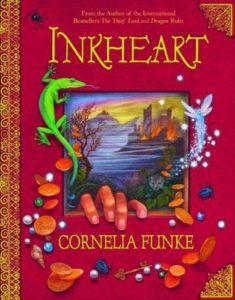
Inkheart, Cornelia Funke
German children’s literature has a glorious tradition of magical interactions with books, from Michael Ende’s The Neverending Story to Mechthild Gläser’s The Book Jumper. While these stories are about entering into books (a closely related but very different trope), Inkheart is about stories coming into the real world: the protagonist, 12-year-old Meggie, discovers that her father Mo has the ability to make characters appear unexpectedly from books when he reads aloud. The cost is that someone or something else will go into the book in its place—as happened years ago, when Meggie’s mother was accidentally read into a book named Inkheart while several of the book’s characters were unleashed upon the world. Diana Wynne-Jones didn’t think she had “ever read anything that conveys so well the joys, terrors and pitfalls of reading” and it’s so, so true, in ways that are easy to feel but very hard to put into words.
What I love about Inkheart is the way in which it celebrates books as physical items. Mo is a book-binder—or, more accurately, a “book doctor”—and the writing teems with information about cover fabric and illustrations, pages and endpapers (“Every book should begin with attractive endpapers . . . When you open a book it’s like going to the theatre. First you see the curtain. Then it’s pulled aside, and the show begins”). Books here need to be protected from sun and smudges and flame, they have weight and texture, they are carried about on journeys and collect memories “like flypapers.” It seems a small step for books’ characters to enter the world when the books themselves are so intensely alive.
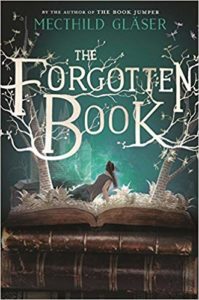
The Forgotten Book, Mechthild Gläser
Sometimes it’s writing, and not reading, that holds power. In this book, the thematic sequel to Gläser’s The Book Jumper, 16-year-old Emma finds an old diary at her German boarding school and realizes that whatever she writes in it comes true. On the cover is a picture of a faun, a fictional character created from the book hundreds of years ago who has disappeared without trace. The book investigates the power books have to shape the world, and the dangers of careless words on those around us: Emma is disturbed, for example, when her wish for an apology from her enemy and future lover Darcy causes him to reveal things she has no right to know, and her anger at him threatens his life. The faun, we learn, has always been in danger from its authors rather than the other way around.
But it’s better than that. The plot itself is a complicated homage to Jane Austen: Emma’s central romance with arrogant Darcy de Winter maps very specifically onto Pride and Prejudice, as you’d expect, but is entwined with characters from Northanger Abbey and Emma (this Emma’s manipulations of reality through the diary are a beautiful analogue for the matchmaking of Austen’s Emma). At the climax, they encounter an immortal, Hampshire-born, 18th-century author, Eleonor Morland, modeled on Austen herself. In this way, the book plays games with the idea of its own fictionality: the characters are at once real, creators of fictional characters within the story world, and overt adaptations of fictional characters themselves. And yet this is never acknowledged in any way, within or outside the text. It’s just there, mysterious and clever, like a code to be unlocked. I love it.
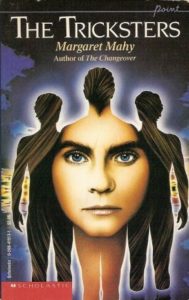
The Tricksters, Margaret Mahy
Similarly, The Tricksters (like so much of Mahy’s work) is a warning of the destructive power of story-telling. Thirteen-year-old Harry’s “secret” is that she is “a writer,” telling a story of a “mysterious and threatening love” between a romantic winged villain and his captive. Her story is melodramatic fantasy, the kind of fiction teenagers write as they explore their fledgeling sexuality—it’s also, we learn later, Harry’s way of working through the more dangerous secret of her father’s infidelity. Her writing pulls through three mysterious “brothers”—Ovid, Hadfield, and Felix—who are at once the embodiment of her Byronic villain and the ghost of murdered child Teddy Carnival, and who take their names from books on the family shelf. And those are easiest parts of the story to explain.
This book is a masterpiece: sharp-edged, elusive, dark and luminous and impossible to pin down. The fictional characters in question are something far more complicated than those in Inkheart, or indeed in any other book in the genre: part manifestation of Harry’s psychology, part supernatural beings with a life of their own, as all characters perhaps are to their authors. Like The Book Jumper, the writing brims with intertextuality, from Harry’s true name of Ariadne to discussions of The Wind in the Willows, but the effect is far more unsettling, creating a world where people can be shaped and rewritten as easily as stories. If stories are dangerous, though, they are also vital. On some level, Harry learns to reject dangerous fantasies, but ultimately she grows into her power as a story-teller and an “enchantress.”
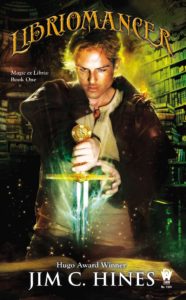
Libriomancer, Jim Hines
One of the most interesting aspects of books where fictional characters come to life is what kind of books the author favors. The Eyre Affair is about classic literature; Inkheart is about children’s books. Libriomancer is about the utter joy of being a nerd. The protagonist, Isaac Vainio, is a libriomancer, a reader who can reach into books and draw out objects from ray-guns to magic potions. He is also an expert on science fiction and fantasy: bookish references to C.S. Lewis and Bram Stoker abound, but so to do references to Doctor Who, Star Wars and The Terminator. Here, the danger of reaching too deeply into a book isn’t that something will come out of the book, but that the book will reach back into you: libriomancers who over-use their magic find themselves hearing voices, and the central “villain” (or victim) of the novel is controlled by a cascade of book villains including Moriarty, Norman Bates, and Hannibal Lecter.
While most characters in this world can’t pass through books, one exception is Lena, a nymph from the (invented) lurid space opera Nymphs of Venus. Lena is written to be the perfect lover, designed to shift her personality to accommodate the other man or woman in the relationship. The book—and Isaac—grapples with the issue of how Lena can pursue a relationship while keeping her autonomy. It acknowledges the more uncomfortable aspects of science fiction/fantasy fandom—specifically, its history of awkward gender politics and the dangers of fantasy.
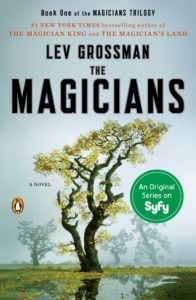
The Magicians, Lev Grossman
Fictional characters don’t come to life in this book so much as they are revealed to have never been fictional at all, but this book still deserves a mention for the way it plays with classic texts and our response to them on every possible level. The plot itself, as has been frequently discussed, is an adult, realist version of Harry Potter, with protagonist Quentin Coldwater accepted to a magic college named Brakebills (though it also echoes magical lessons from T.H. White and Ursula Le Guin). At the same time, Quentin is obsessed with a Narnia-esque series of children’s books, Fillory and Further. These books turn out to be real, and Quentin and his friends journey to Fillory only to find a nightmare world with the central protagonist transfigured into a monster.
This book is more than intertextual: it’s having a very explicit (in more ways than one) conversation with children’s fantasy, from Narnia to Harry Potter to Earthsea to The Sword in the Stone. It is telling that so many books about characters coming to life are children’s books: I suspect that this is partly because memories of childhood reading are so vivid and unselfconscious, and partly because the conventions of children’s literature allow the veil between fantasy and reality to be even more porous. Grossman’s book is about children’s fantasy brought into the real adult world, whether implicitly (in the case of Brakebills) or literally (in the case of Fillory, regarded as fiction within the book itself), and the effect is not only dangerous but dark, violent, and disillusioning.
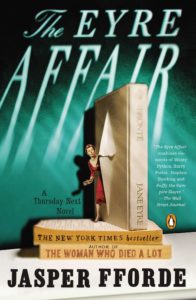
The Eyre Affair, Jasper Fforde
And then there’s Jasper Fforde. There is something very, very special about books that employ the kind of education and intelligence and wordsmithery that could be used for a Serious Novel to make people laugh. This series, following the adventures of literary detective Thursday Next in a parallel world where literature is everything and characters come in and out of books, is very special. It’s perhaps the most well-known book of its kind, and so I love that it’s also the most joyful and ridiculous.
While some books invent characters to bring to life, the joy of Fforde’s world is recognizing some of the most loved characters in English Literature and their foibles: on one level, the series is one great, glorious in-joke. It’s far more than that, of course. The Eyre Affair has wild, chaotic fun not only with classic literature but with time, space, and reality; it also celebrates readers’ love of books, explores the boundaries between reality and fiction, and explains the twist at the end of Jane Eyre. Reading as scholarship and reading for enjoyment are indistinguishable here, as they should be: the well-worn academic question of whether Shakespeare wrote his own plays is a recurring joke with a brilliant punch-line. Plus, you get to spend a lot of time with Mr Rochester, which is exactly what you want from a book.
___________________________________

H.G. Parry’s novel The Unlikely Escape of Uriah Heep is out now from Redhook.
H.G. Parry
H.G. Parry lives in a book-infested flat in Wellington, New Zealand, which she shares with her sister and two overactive rabbits. She holds a PhD in English Literature from Victoria University of Wellington, and teaches English, Film, and Media Studies. Her short fiction has appeared in Intergalactic Medicine Show, Daily Science Fiction, and small press anthologies. The Unlikely Escape of Uriah Heep is her debut novel.



















